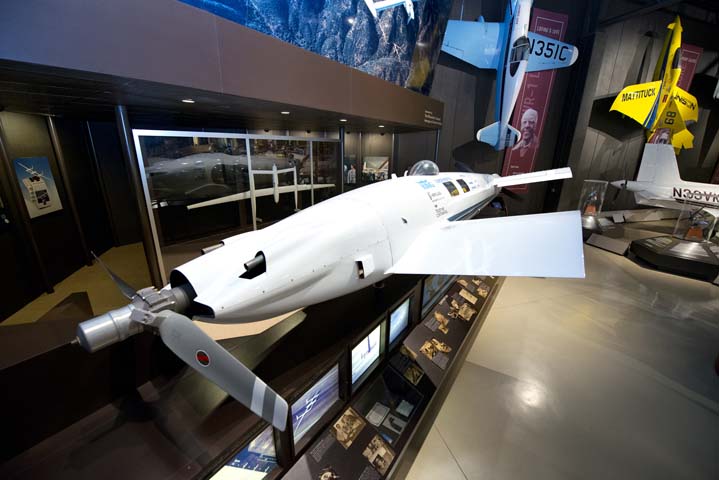Scaled Composites/Rutan Voyager Partial Replica
Location: Innovations
On December 23, 1986, the Burt Rutan-designed Voyager aircraft landed at Edwards Air Force Base in California, completing the first nonstop, non-refueled flight around the world by an airplane. Its flight of 26,366 statute miles lasted 9 days, 3 minutes, and 44 seconds, piloted by Dick Rutan and Jeana Yeager.
Today, the Voyager aircraft is displayed in the Smithsonian’s National Air & Space Museum in Washington, D.C. The centerpiece of the Voyager exhibit in the EAA Aviation Museum is a full-scale replica of the Voyager’s fuselage and cockpit/cabin.
Burt made his reputation with innovative designs for homebuilt aircraft, including the VariViggen, VariEze, Long-EZ, and others. He and Dick conceived the idea of a nonstop, non-refueled, around-the-world flight in 1980. They predicted the project would take 18 months — it took 6 years.
Construction of the Voyager began in the summer of 1982, with a first flight two years later. The airframe was built without metal components. The main material used was a composite sandwich of paper honeycomb and graphite fiber, molded and oven-cured. Weight-saving materials kept the airframe to a structural weight of just 939 pounds.
Voyager is, in effect, a flying fuel tank. Its gross takeoff weight for the record flight was 9,694.5 pounds, of which 7,011 pounds was fuel, carried in 17 tanks. When the flight ended nine days later, only 140 pounds of fuel remained.
Power came from two engines, one at each end of the fuselage. The rear engine, a 110-hp air-cooled Teledyne Continental IOL-200 ran for all but eight minutes of the flight, when a fuel feed problem shut it down. The front engine, a 130-hp, air-cooled Teledyne Continental O-240, provided takeoff and climb power, and backup for the rear engine. Both engines swung aluminum Hartzell constant-speed, variable pitch propellers.
In the cramped cabin, the on-duty pilot (sitting on the right) flew the airplane, navigated, communicated with the ground, and transferred fuel to keep the airplane in trim. The off-duty pilot (lying on the left or behind) helped with navigation and flight monitoring, managed flight logistics, and rested — though in fact, neither pilot got much rest during the nine-day flight.
Voyager’s official average speed during the around-the-world flight was 116 mph. Its altitude averaged around 11,000 feet, climbing as high as 20,500 feet. Voyager’s route was set with the help of a team of meteorologists who guided the pilots around storms and into favorable winds.
Voyager’s flight was a stunning triumph, accomplished by Burt’s project team, a host of volunteers, many small private contributions, and no government sponsorship.
Original Voyager Specifications:
Length: 29 feet
Wingspan: 110 feet, 8 inches
Empty Weight: 939 pounds
Gross Weight: 9,700 pounds
Seats: 2
Maximum Speed: 150 mph
Cruise Speed: 116 mph
Powerplants: One Teledyne Continental O-240 (fore), one Teledyne Continental IOL-200 (aft)
Horsepower: 130 hp (fore), 110 hp (aft)
Range: 27,000 miles




